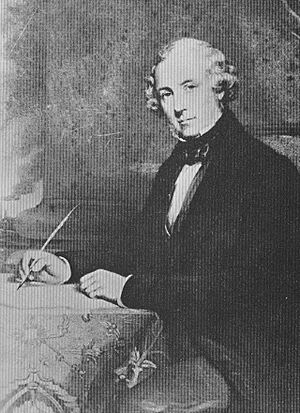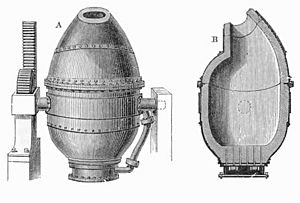Dowlais Ironworks facts for kids
The Dowlais Ironworks was a huge factory in Dowlais, near Merthyr Tydfil, in Wales. It was a very important place where iron and later steel were made. It started in the 1700s and kept working until the late 1900s. For a while in the 1800s, it was the biggest steel maker in the whole United Kingdom.
Dowlais Ironworks was the first company to use a new way of making steel called the Bessemer process in 1865. It was one of the four main ironworks in Merthyr, along with Cyfarthfa, Plymouth, and Penydarren Ironworks. In 1936, something interesting happened when Edward VIII, who was King at the time, visited the steelworks. He saw that many people were out of work and said, "these works brought these men here. Something must be done to get them back to work." This comment was seen as the King getting involved in politics, which was unusual. The steelworks finally closed its doors in 1987.
Contents
How it All Began (1759–1807)
The Dowlais Ironworks started as a business partnership on September 19, 1759. There were nine original partners, including Thomas Lewis and Isaac Wilkinson. They wanted to build a furnace to melt iron ore into pig iron in Merthyr Tydfil. They planned to use a shared fund of £4,000 to get started.
Thomas Lewis helped the partnership by providing special agreements called leases. These leases allowed them to build a furnace and dig for iron ore, coal, and limestone in the Dowlais area. Isaac Wilkinson brought his special machine for blowing air into the furnaces, which was very important for making iron. The other partners brought money and more land rights.
The first furnace was built on a hillside above Merthyr. Even though the location wasn't perfect, all the materials needed to make iron were close by. At first, the business struggled because the owners were too busy. So, on April 13, 1767, John Guest was hired to manage the works. In 1781, John Guest bought more shares in the company, and a second furnace was built. His son, Thomas Guest, took over in 1786. Thomas Guest and his son-in-law, William Taitt, formed the Dowlais Iron Company. Thomas Guest brought in many new ideas, and the works became very successful.
The Time of John Josiah Guest (1807–1852)
When Thomas Guest passed away in 1807, his son John Josiah Guest became the main manager. By 1815, he owned most of the company. John Josiah Guest was a very important figure in the Industrial Revolution. He made sure Dowlais Ironworks used the latest scientific ideas in its work. The famous scientist Michael Faraday even visited the works in 1819! Under Guest's leadership, along with his manager John Evans, Dowlais Ironworks became known as "one of the World's great industrial concerns."
In 1821, the works provided the iron for the tracks of the Stockton and Darlington Railway. This was the world's first railway for passengers. Over the next 30 years, more and more iron was needed to build the fast-growing railways. Dowlais even received orders from other countries in 1835–1836 for railways in places like Berlin and St. Petersburg.
Around 1835, Guest met an engineer named G. T. Clark. They both worked on the Taff Vale Railway. In 1850, Clark married Ann Price Lewis, who was a descendant of Thomas Lewis, one of the original partners. Ann's brother sold the family's last shares in the company to Guest that same year.
At its busiest in 1845, Dowlais Ironworks had 18 blast furnaces working. It employed 7,300 people and produced 88,400 tons of iron every year.
New Beginnings: Clark and Menelaus (1852–1899)
John Josiah Guest died in 1852. He had become the sole owner of the works in 1851. He named G. T. Clark, his wife Lady Charlotte Guest, and Edward Divett as the people who would manage his business after he was gone. Lady Guest was the main manager while she was a widow. But when she remarried in 1855, Clark took over the real control. Henry Bruce later replaced Divett.
The works had been slowing down for a bit, so Clark quickly made changes to improve how things were managed. He brought in William Menelaus as the general manager. They worked very well together, and Dowlais once again became a place for new ideas. Even though they got a special permission to use the Bessemer process in 1856, it took nine years of careful planning before they made their first steel. The company did very well with its new, cheaper ways of making steel. They even worked with other big companies like the Consett Iron Company and Krupp. By 1857, Clark and Menelaus had built the "Goat Mill," which was the most powerful rolling mill in the world.
In 1863, the company had recovered from a tough business time and was making a profit. However, they didn't have enough money to build a new blast furnace. To explain why, the manager created a new financial report called a comparison balance sheet. This report showed that the company had too much unsold iron. This new report was the start of what we now call a Cash Flow Statement, which is used by businesses today.
By the mid-1860s, Clark's changes had made the company profitable again. Clark let Menelaus handle the daily management. Clark's role as a trustee ended in 1864 when ownership went to Sir Ivor Guest. However, Clark continued to guide the company's plans, especially building a new factory at the docks in Cardiff. He officially retired in 1897.
The GKN Era (1899–1973)
Sir Ivor Guest was busy with other things, so in 1899, he sold the works to Arthur Keen. Arthur Keen then formed a new company called Guest, Keen & Co. Ltd. In 1902, Keen bought another company called Nettlefolds Limited to create the even bigger company, Guest, Keen and Nettlefolds (GKN).
In 1912, King George V of the United Kingdom and Queen Mary visited the ironworks as part of their trip to south Wales. They walked through a special arch made of coal when they arrived, and left through an arch made of steel!
Unlike some other ironworks, Dowlais was able to switch to making steel early on. This helped it survive into the 1930s. However, because of the Great Depression, the main works stopped making steel in 1936. The company had already built a new iron and steel factory in East Moors, near the docks in Cardiff, in the late 1800s.
King Edward VIII's Visit
On November 18, 1936, King Edward VIII visited Dowlais Ironworks. At that time, the factory was closed, which meant thousands of people were out of work. The King was reported to have said, "these works brought these men here. Something must be done to get them back to work." This statement was seen as the King getting involved in political matters, which was not usually done by the monarch. This event was one of the things that led to the Edward VIII abdication crisis, where the King gave up his throne.
The part of Dowlais that made iron castings and did engineering work, still known locally as the "Ifor Works," kept operating. New facilities were even built there after 1945.
British Steel and the End (1973–1987)
The company continued for some years as the Dowlais Foundry and Engineering Company. But in 1973, it became part of the government-owned British Steel Corporation. It finally closed down in 1987.



